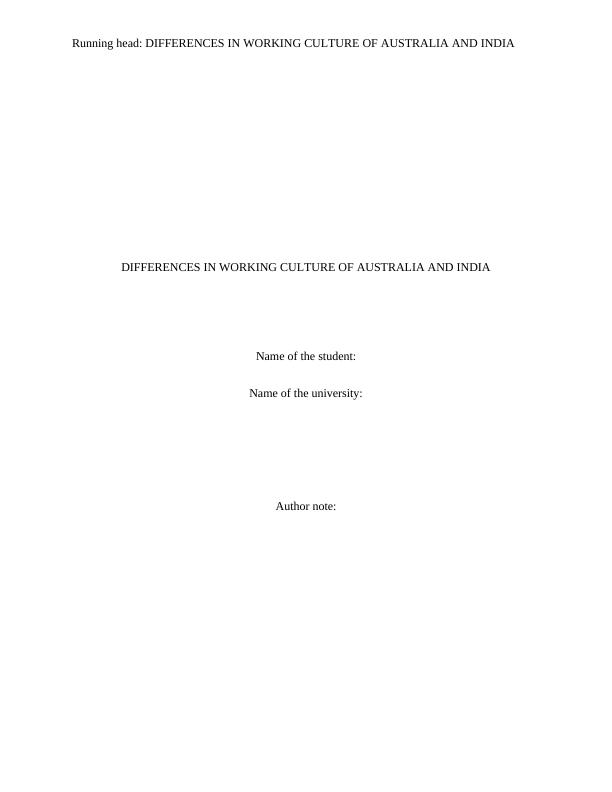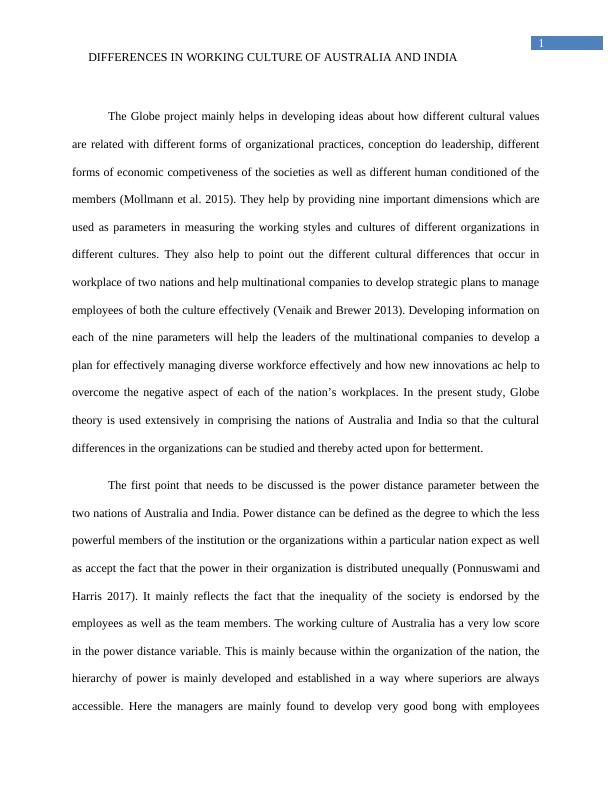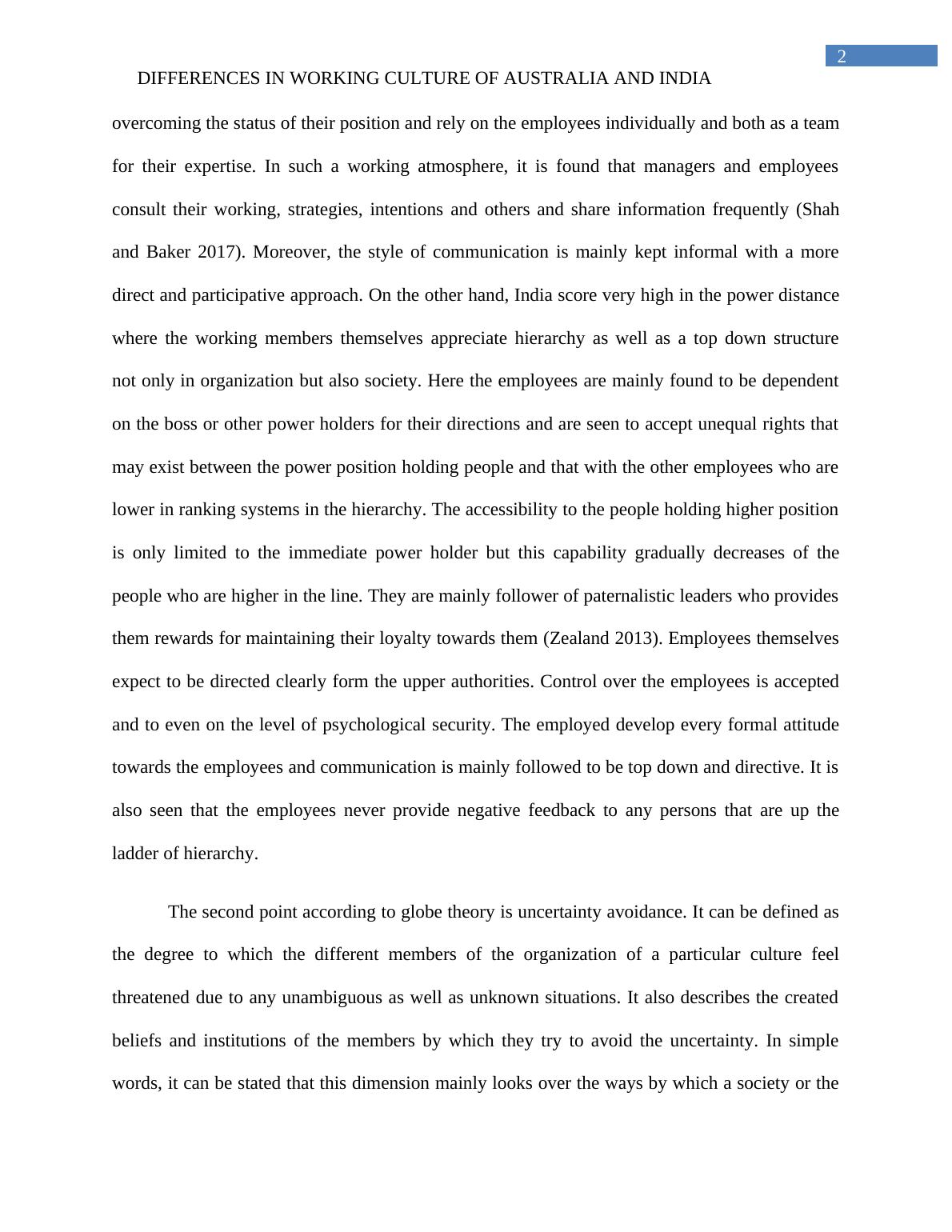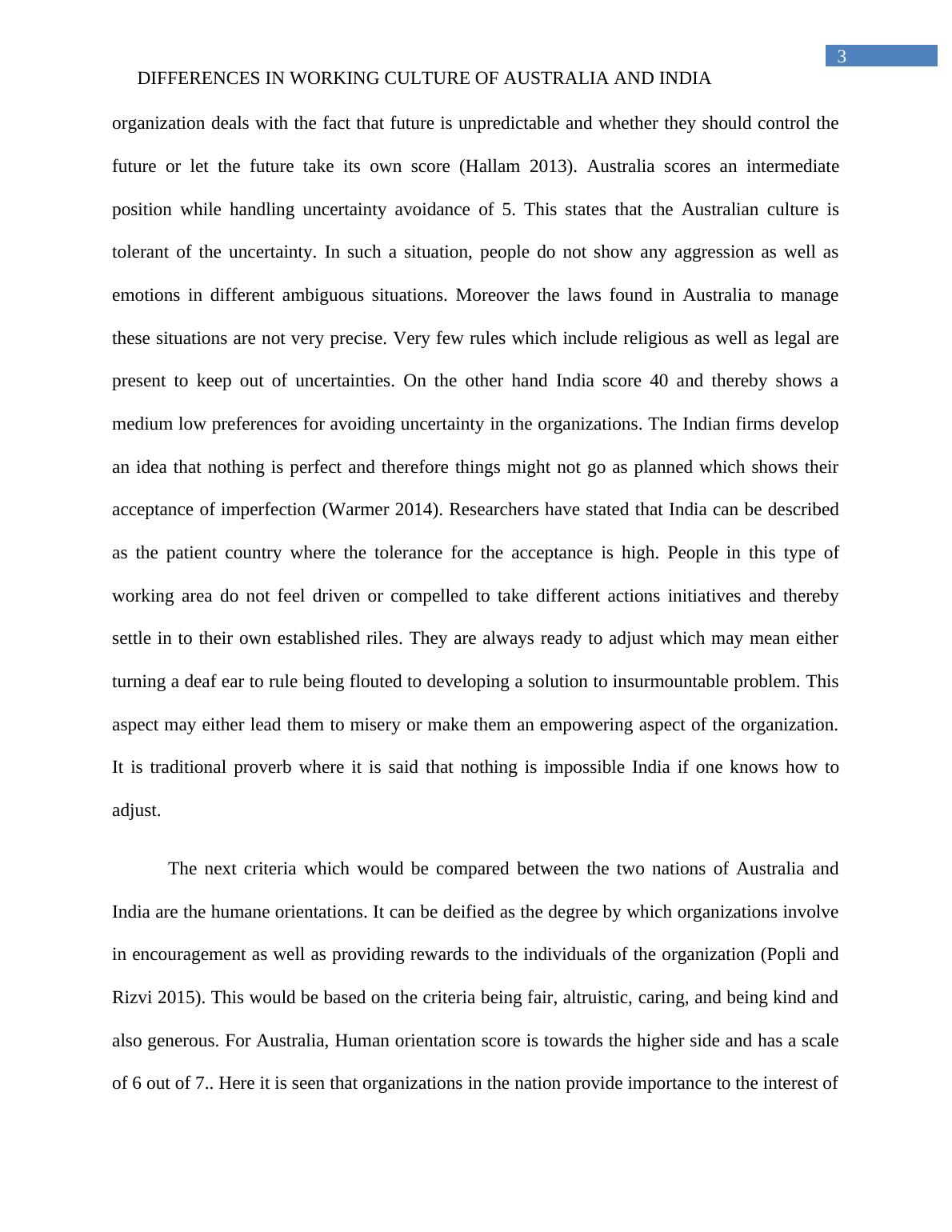Difference in Working Culture of Australia and India
18 Pages4949 Words45 Views
Added on 2020-04-07
Difference in Working Culture of Australia and India
Added on 2020-04-07
ShareRelated Documents
Running head: DIFFERENCES IN WORKING CULTURE OF AUSTRALIA AND INDIADIFFERENCES IN WORKING CULTURE OF AUSTRALIA AND INDIAName of the student:Name of the university:Author note:

1DIFFERENCES IN WORKING CULTURE OF AUSTRALIA AND INDIAThe Globe project mainly helps in developing ideas about how different cultural valuesare related with different forms of organizational practices, conception do leadership, differentforms of economic competiveness of the societies as well as different human conditioned of themembers (Mollmann et al. 2015). They help by providing nine important dimensions which areused as parameters in measuring the working styles and cultures of different organizations indifferent cultures. They also help to point out the different cultural differences that occur inworkplace of two nations and help multinational companies to develop strategic plans to manageemployees of both the culture effectively (Venaik and Brewer 2013). Developing information oneach of the nine parameters will help the leaders of the multinational companies to develop aplan for effectively managing diverse workforce effectively and how new innovations ac help toovercome the negative aspect of each of the nation’s workplaces. In the present study, Globetheory is used extensively in comprising the nations of Australia and India so that the culturaldifferences in the organizations can be studied and thereby acted upon for betterment.The first point that needs to be discussed is the power distance parameter between thetwo nations of Australia and India. Power distance can be defined as the degree to which the lesspowerful members of the institution or the organizations within a particular nation expect as wellas accept the fact that the power in their organization is distributed unequally (Ponnuswami andHarris 2017). It mainly reflects the fact that the inequality of the society is endorsed by theemployees as well as the team members. The working culture of Australia has a very low scorein the power distance variable. This is mainly because within the organization of the nation, thehierarchy of power is mainly developed and established in a way where superiors are alwaysaccessible. Here the managers are mainly found to develop very good bong with employees

2DIFFERENCES IN WORKING CULTURE OF AUSTRALIA AND INDIAovercoming the status of their position and rely on the employees individually and both as a teamfor their expertise. In such a working atmosphere, it is found that managers and employeesconsult their working, strategies, intentions and others and share information frequently (Shahand Baker 2017). Moreover, the style of communication is mainly kept informal with a moredirect and participative approach. On the other hand, India score very high in the power distancewhere the working members themselves appreciate hierarchy as well as a top down structurenot only in organization but also society. Here the employees are mainly found to be dependenton the boss or other power holders for their directions and are seen to accept unequal rights thatmay exist between the power position holding people and that with the other employees who arelower in ranking systems in the hierarchy. The accessibility to the people holding higher positionis only limited to the immediate power holder but this capability gradually decreases of thepeople who are higher in the line. They are mainly follower of paternalistic leaders who providesthem rewards for maintaining their loyalty towards them (Zealand 2013). Employees themselvesexpect to be directed clearly form the upper authorities. Control over the employees is acceptedand to even on the level of psychological security. The employed develop every formal attitudetowards the employees and communication is mainly followed to be top down and directive. It isalso seen that the employees never provide negative feedback to any persons that are up theladder of hierarchy. The second point according to globe theory is uncertainty avoidance. It can be defined asthe degree to which the different members of the organization of a particular culture feelthreatened due to any unambiguous as well as unknown situations. It also describes the createdbeliefs and institutions of the members by which they try to avoid the uncertainty. In simplewords, it can be stated that this dimension mainly looks over the ways by which a society or the

3DIFFERENCES IN WORKING CULTURE OF AUSTRALIA AND INDIAorganization deals with the fact that future is unpredictable and whether they should control thefuture or let the future take its own score (Hallam 2013). Australia scores an intermediateposition while handling uncertainty avoidance of 5. This states that the Australian culture istolerant of the uncertainty. In such a situation, people do not show any aggression as well asemotions in different ambiguous situations. Moreover the laws found in Australia to managethese situations are not very precise. Very few rules which include religious as well as legal arepresent to keep out of uncertainties. On the other hand India score 40 and thereby shows amedium low preferences for avoiding uncertainty in the organizations. The Indian firms developan idea that nothing is perfect and therefore things might not go as planned which shows theiracceptance of imperfection (Warmer 2014). Researchers have stated that India can be describedas the patient country where the tolerance for the acceptance is high. People in this type ofworking area do not feel driven or compelled to take different actions initiatives and therebysettle in to their own established riles. They are always ready to adjust which may mean eitherturning a deaf ear to rule being flouted to developing a solution to insurmountable problem. Thisaspect may either lead them to misery or make them an empowering aspect of the organization.It is traditional proverb where it is said that nothing is impossible India if one knows how toadjust.The next criteria which would be compared between the two nations of Australia andIndia are the humane orientations. It can be deified as the degree by which organizations involvein encouragement as well as providing rewards to the individuals of the organization (Popli andRizvi 2015). This would be based on the criteria being fair, altruistic, caring, and being kind andalso generous. For Australia, Human orientation score is towards the higher side and has a scaleof 6 out of 7.. Here it is seen that organizations in the nation provide importance to the interest of

End of preview
Want to access all the pages? Upload your documents or become a member.
Related Documents
Cultural Analysis for Business in Different Countrylg...
|9
|2516
|460
International management assignmentlg...
|8
|2187
|62
Assignment of Management PDFlg...
|12
|3010
|44
Cross Culture Managementlg...
|9
|2115
|83
Hofstede Cultural Dimensions in International Businesslg...
|5
|1031
|453
Cross Cultural Managementlg...
|13
|4043
|335
